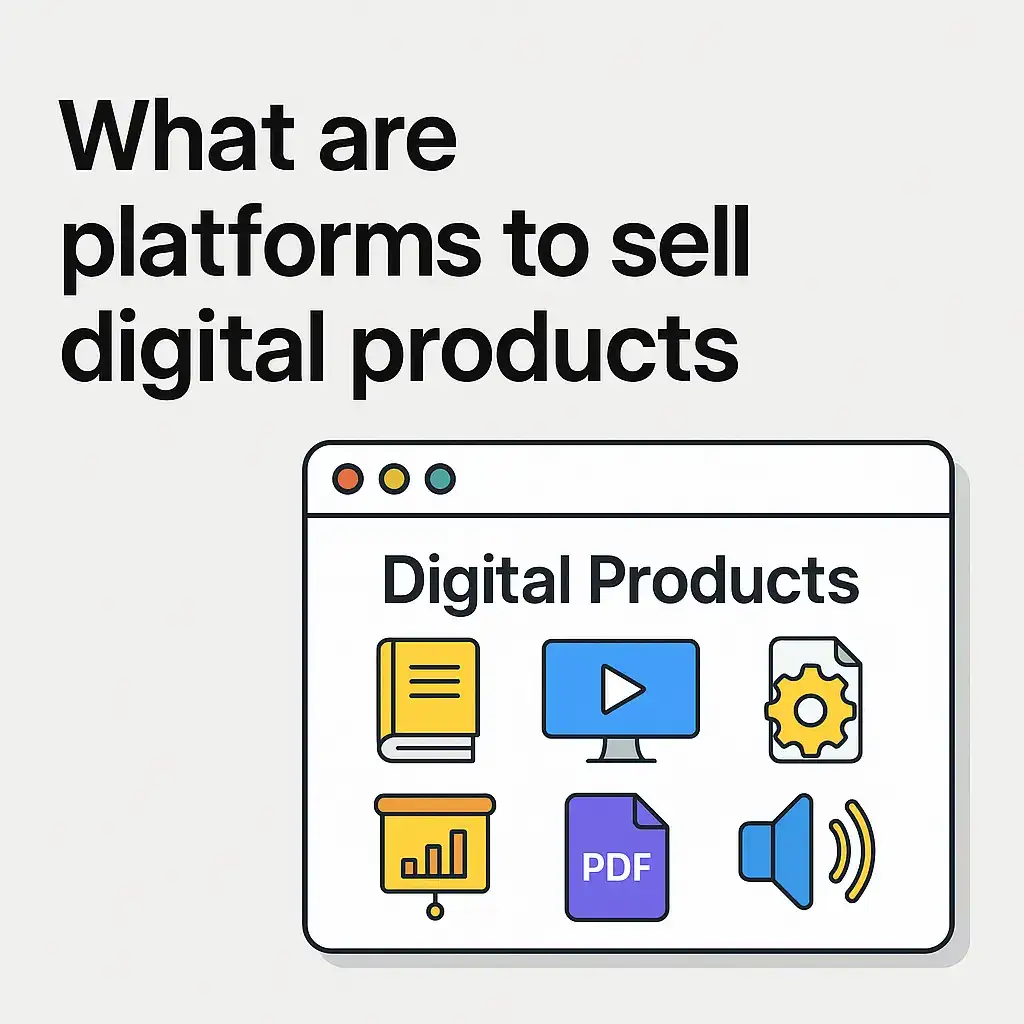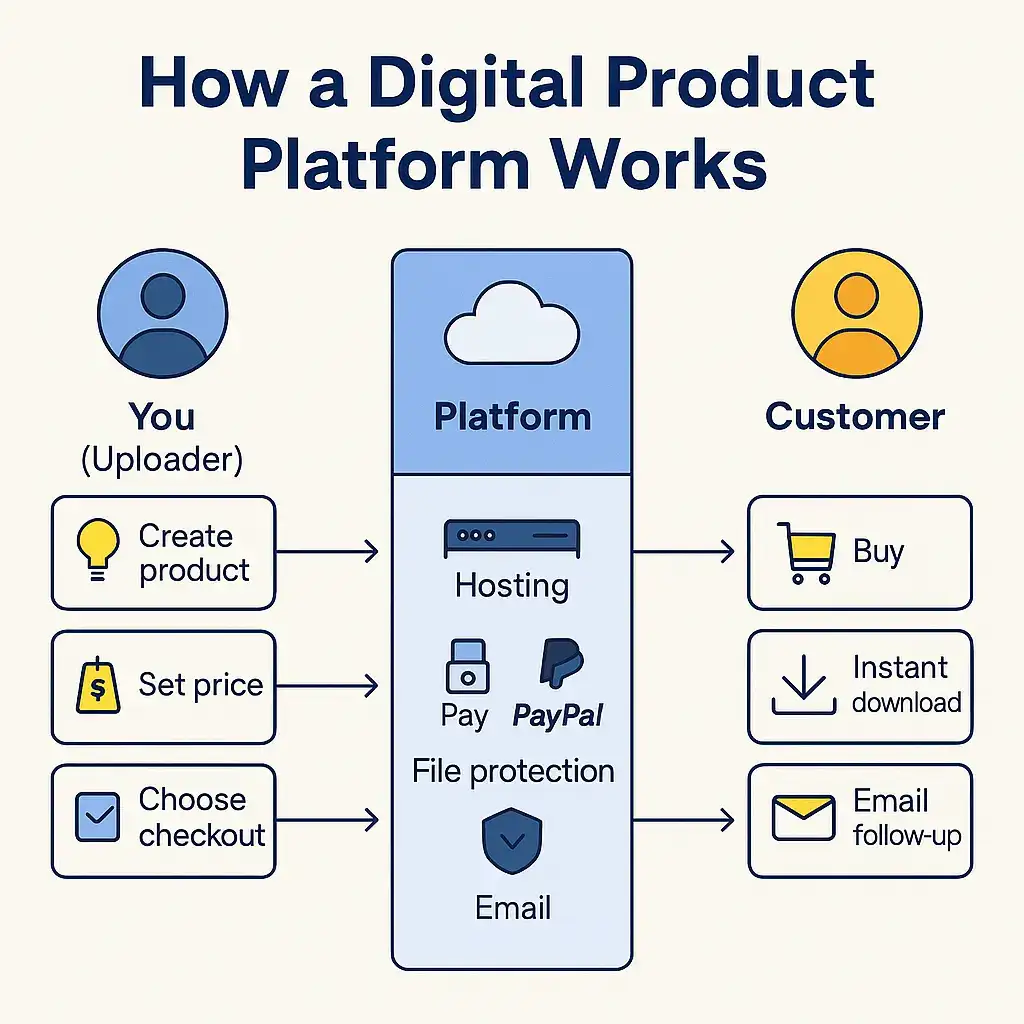We test and review software products using an independent, multipoint methodology. If you purchase something through our links, we may earn a commission. Read about our editorial process.
Digital product selling platforms are the software or online services created to enable their owners, developers, and creators to sell digital merchandise to customers instead of physical items. These products encompass common types of digital products such as ebooks, online courses, software, templates, PDFs, sound effects, or any downloadable products.
These sites deal with the critical aspects of ecommerce- storing the digital files, taking payments through payment gateways, such as stripe or PayPal, and downloading the files immediately after proceeding through check out. They do not require construction of a specific web-site or server-side system to be able to sell digital goods online.

Most of the top platforms to sell digital products also feature an in-built marketing software, which is provided with email campaigns, affiliate programs, social media integrations, analytics dashboards, and many other great features. Certain platforms will aim at a particular product type: a marketplace selling code, an online learning platform, or an online store, whereas others will be more general and facilitate a variety of digital formats.
Examples are popular Easy Digital Downloads to create WordPress-based e-commerce, SendOwl to deliver simple course and Thinkific or Teachable to sell online courses with key features that attract small companies. Other platforms also have entry points that are free or relatively cheap, and that is why they can be used by small companies and individual creative sellers.
The tools are popular among digital product companies and help to make business transactions smooth, delivery automated, and make money passively without moving physical objects.
In order to compete in 2025, the finest platforms that one can use to sell the digital products should be securely hosted on a reliable hosting account, with rapid deliverance and should accommodate the numerous types of files. Paying to be entitled to receive things immediately in the digital form is a minimum necessary expectation by all consumers.
One must have a flexible check out system. It ought to accommodate the inception of large gateways such as Stripe and PayPal, possess tax/VAT management, and be mobile. The pricing by region and different currencies is also the standard practice in the platforms that sell in the international markets including India.
Email marking features should be inbuilt or should have direct integration with such services as MailerLite, AWeber or SendPulse. Artists use automated email workflows to market a new digital resource, send freebies to generate leads and to make repeat sales to already existing clients.
The feature of subscriptions, bundles and discount codes is essential in online courses, ebooks or template websites businesses. These characteristics mean increment of average order value and the possibility of a recurrent revenue.
Strong analytics, and customer tracking are useful to sellers to track down loads, rates of conversion, and customer movement. Performance marketing is important in integrating with platforms such as; Facebook Ads, Google Analytics, and YouTube.
At last, the most appropriate site to sell digital items must provide affiliate services, allow delivering the license key to a purchase (in case of selling software or application), and provide a free plan or trial to decrease the barrier to entry among those creators who have just started their business online.
App stores selling digital goods are directed at individuals, small-time entrepreneurs, educators and software developers. Thematically, these users sell downloadable products like ebooks, PDF templates, online course, apps, digital art and sound effects, among others.
Through such platforms as Thinkific, LearnDash, and Teachable, the creators of the courses can construct and market some structured learning content online. On Sellfy, Payhip, or Podia, designers and marketers sell templates or digital planners on Canva, or decks of presentations. To sell code, plugins, digital files and similar software products, the software developer uses such tools as Easy Digital Downloads or SendOwl.
The platforms also favor those who would use email marketing to earn money, affiliate programs or the followers on the social media sites like Instagram. These are digital products consumers who are bloggers and YouTubers and other influencers who count on content marketing or passive income strategies, making them a great place to explore effective marketing strategies.
Last but not least, sellers in price-sensitive economies such as India would best do business on platforms supporting localized payments and offering comparatively low transaction fees because such economies are building on digital entrepreneurship by using low-overhead online companies.
The user has to upload a digital file--in other words, an ebook, a PDF file, audio, video, or piece of software, to the site in order to start selling. The seller decides on prices, delivery settings, and customize the checkout procedures such as payment mechanism to be used either through stripe or PayPal.
As soon as a customer makes a certain purchase, the program automatically charges his or her credit card and provides a digital download. To protect the content, most of the tools provide the option of file protection, maximum downloads, and expiration.

Others have email capture features that enable the sellers to create a mailing list that can be used to do the promotion. Some are also connected to an email marketing service such as MailerLite, AWeber or SendPulse that can be used to follow up with contacts or provide links.
Another alternative is a subscription option or free trial of the products by the sellers. Such platforms as Sellfy and Systeme.io allow creating upsells, discount coupons, and affiliate programs to increase the outreach and conversion.
Any activity including sales, traffic and conversion rates are monitored using an in-built analytics dashboard. This gives the sellers an opportunity to analyse the performance of their products, pricing, and marketing in the social media sites, blogs, or even You Tube.
The first thing to do is to review the supported digital products of the platform, as some services specialize in online courses, and others are better suited to ebooks, templates, or code files. When you want to sell a variety of formats, including your own website and any kind of digital product, select a platform where the uploading of files and the delivery of digital contents can be customized.
Check on transaction charges and more on a monthly price as well as a free plan option. The rates are either per sale or prepaid amount that will be offered on some of the platforms. When aiming at international clients, you should ensure that the platform manages the taxes, currency exchange, and accepts Stripe, PayPal, or payment systems of that area, particularly India.
Assess marketing features and marketing tools. Find out whether you can find in-built email marketing, and affiliate program, or integration with such tools as MailerLite, SendPulse, or AWeber. In case you drive traffic using Youtube, blogs or social media make sure that the medium gives you complete control of customizing checkout and branding.
Test its subscription, license and file protection. In the case of software and digital downloads it is necessary to send the license keys and set the limit of downloads. Analytics, CRM features and lead capturing aspects must be made available to creators that are concerned with the generation of passive income or building a brand.
Lastly, ensure that, you own your customer data. Certain platforms are marketplaces and do not allow access to buyers information. This is one of the main selection criteria, in case you base on follow-up emails or the audience segmentation.
Digital product platform does not involve constructions of custom ecommerce system. It offers file hosting, payment service, secure web based downloads and customer management solution.
These programs make it automatic so that customers can check out, file delivery and order confirmation. This saves the manual labor and the buyers get what they buy as they become the digital user. The security measures such as download restrictions and distribution of license keys make sure that it is not shared unreasonably.
Most of the sites have an in-built email marketing option or can connect to external suppliers such as MailerLite, SendPulse or AWeber. This assists in the growth of audience, contacting potential customers, and marketing of new digital content by sellers.
Increasing lifetime customer value involves offering support to subscriptions, discounting and bundled offers. Analytics dashboards on platforms also indicate success of sales, download history and conversion rates on different campaigns on social media, blogs or even YouTube.
Small business owners in growing economies such as India are facing a small entry barrier in the digital business as it requires paying localised supported platforms. This helps to make passive income with fewer efforts needed in terms of handling physical products and delivering them.
It is a choice that reveals the most competent site to sell online digital products and other digital items depending on the type of content you plan to sell, digital product business model, and the marketing strategy you intend to use. In case of online courses, structured learning can be provided with the help of such tools as Thinkific or Teachable. To sell ebooks, templates, or software, there are such flexible platforms as Sellfy, Easy Digital Downloads, and Payhip in delivering files and presenting checkout services.
Avoid ones that do not allow you to grow (email marketing, affiliate programs, built-in analytics) and prefer the ones that do. Ensure that it supports subscription, bundle and international payment, particularly when the markets to be catered are such as India.
Check the fee charged on transactions, the availability of a free plan, and the compatibility of the services with the tools you work with now (e.g., Stripe, MailerLite, WordPress). The platforms, which have limitations on access or the necessary control, such as license control or file protection, should be avoided.
The selection of a digital product platform enhances the delivery time, automates the selling process, and, most importantly, eases the way you operate your ecommerce business in 2025.
Payhip and Systeme.io are the providers of good free plans to manage the basic features like checkout, file delivery, and elementary email marketing. They both can sell ebooks, PDF files and other simple digital products, making Payhip a best place for creators without payments.
Yes. Sellfy, Gumroad and DPD allow you to make individual product pages. Selling pages have in-built checkout and file distribution which means that you do not need any other web site or hosting.
Systeme.io, Payhip, and SendOwl make international payments, and INR with PayPal or Stripe is included. They are also suitable to Indian creators starting an online business since its low costs and free plans notifications make it a good choice.
Systeme.io, Payhip, and SendOwl make international payments, and INR with PayPal or Stripe is included. They are also suitable to Indian creators starting an online business since its low costs and free plans notifications make it a good choice.
Yes. On platforms such as ClickFunnels, Podia and Sellfy, it is possible to use and offer recurring payments, product bundles and up-sells post purchase. The features serve to raise the average order value and make possible passive revenues with digital content.